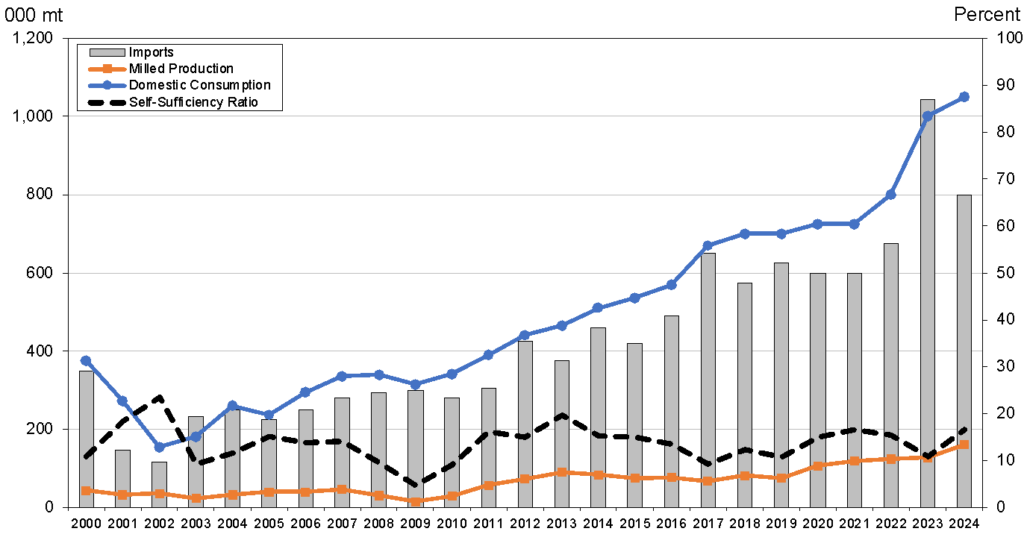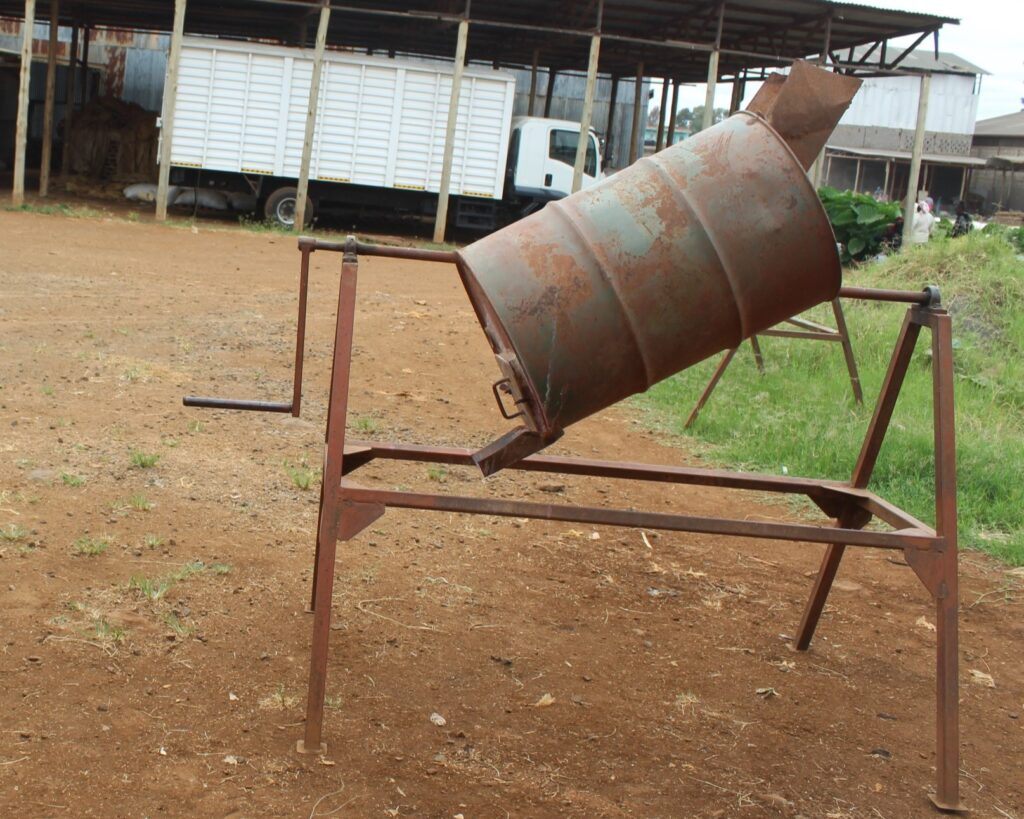by Shilomboleni, Helena; Murori, Rosemary; Njau, Simon; Musila, Ruth; Panchbhai, Ajay; Menge, Daniel; Ismail, Abdelbhagi; and Connor, Melanie

Key messages:
- A high-yielding, moderately climate-resilient rice variety, Komboka (IR05N221), meaning “to ‘liberate”, was introduced in Kenya in 2013.
- Despite favorable traits such as a higher number of tillers, uniform crop stand, higher yield and disease resistance, the adoption of Komboka was slow and it remained unknown for six years since its release.
- In 2020, the Mwea Rice Growers Multipurpose Cooperative Society (MRGM) became a local champion for Komboka, working with the technology’s developers and local partners to support its dissemination and create awareness among Kenyan rice farmers.
- These efforts helped to stimulate the rapid uptake of Komboka when rice farmers started recognizing its high yield, good eating quality, and high ratooning ability, as well as its contribution to food and income security.
- Achieving the long-term sustainability of a promising innovation requires meaningful collaboration with key local partners and product managers from the start as well as a rigorous preference assessment of farmers, processors, and consumers to inform breeding programs.
There is a burgeoning demand for rice across Africa, driven largely by changing food habits, urbanization, and population growth. This is putting economic pressure on governments as they pay for rice imports (Ibrahim, et al. 2021; Futakuchi, et al. 2021). To close the widening gap between the rising consumption demand and the current production across Africa, 32 countries with agro-climatic conditions suited for rice production have implemented national rice development strategies as part of a continent-wide initiative by the Coalition for African Rice Development.
The respective national governments are working with various rice stakeholders to boost rice production through a combination of measures, such as building domestic capacity in breeding and agronomy, quality seed production and dissemination following, rice quality standards, scale-appropriate mechanization, and the efficient use and management of inputs including fertilizers and irrigation water resources.
Rice is a national priority crop in Kenya, and the government has developed the second phase of its National Rice Development Strategy (NRDS II) to increase domestic milled rice production by seven-fold, from 128,000 metric tonnes (MT) in 2018 to 846,000 MT by 2030 (Republic of Kenya, 2020). Kenya’s ambitions to achieve rice self-sufficiency is a response to a sharp rise in per capita rice consumption, from 12 kg in 2016 to 28 kg in 2022, equivalent to 1.2 million MT (Ng’ang’a 2023).
The Mwea Rice Growers Multipurpose (MRGM) Cooperative Society in Kirinyaga County, Kenya is helping to boost domestic rice production. With over 7,000 members, MRGM is the largest farmers’ cooperative in East Africa. MRGM is also a registered seed producer and merchant working to ensure that its members and other rice growers in Kenya have affordable access to new high-yielding rice varieties. This summer, researchers from the University of Waterloo, Ontario Canada and the CGIAR initiative on Market Intelligence conducted a study to better understand farmers’ adoption of climate-resilient rice varieties and the role that various partners play in facilitating seed access. They spent time with MRGM farmers and with other rice stakeholders in the country to learn about the efforts of various actors.
Coalescing around Kenya’s National Rice Development Strategy
MRGM has a longstanding experience in rice production and marketing going back nearly 60 years. The cooperative is located in Mwea, Kirinyaga County, which accounts for about 80% of the rice produced in the country. However, rice production trends have remained historically low (Figure 1) in part due to the use of old varieties, some released over 30 years ago, that are low-yielding, susceptible to diseases, and sensitive to environmental stresses (Ng’endo et al. 2022). Among the old but popular varieties are Basmati 217 and Basmati 370, which although low yielding (less than 5 t/ha) have traits, such as aroma and long-slender grains, that are preferred by consumers.
MRGM has been involved in the seed multiplication of these varieties on a small scale to facilitate farmer access.

Over the past decade, however, a national impetus to achieve Kenya’s NRDS-II targets has catalyzed collaboration among different stakeholders working on rice. In 2018, MRGM started working closely with key players in the rice value chain to expand seed production and dissemination of new high-yielding varieties. One notable collaboration is between the cooperative, the Kenya Agricultural and Livestock Research Organization (KALRO), the Ministry of Agriculture, the International Rice Research Institute (IRRI) and Kilimo Trust to deliver Komboka (IR05N221) into the hands of rice farmers.
Komboka was initially released in Tanzania in early 2013 and in Kenya later in the same year. The variety has multiple favorable traits, including high yield (about 7 t/ha) and moderate tolerance to drought. It is also a semi-aromatic and medium-maturing variety (Ng’endo et al. 2022).
Komboka’s stress-tolerance traits matter considering that smallholder rice production systems are especially susceptible to virulent pathogens that can wipe out 50-80% of yields, heat, salinity, and flooding which further threaten agricultural productivity and food security (Ismail and Atlin, 2019; Siddiq and Vemireddy, 2021). Compared to other rice varieties released in Kenya, Komboka is able to withstand stressful conditions and still produce high yields with good grain quality.
Scaling Komboka rice
Despite its good qualities, the variety’s adoption rates in Kenya remained low until recently. T According to an MRGM informant, the cooperative and their rice farmers in Mwea had little awareness of Komboka and its adoption rates stagnated at less than 3% until 2019.
This started to change with the MRGM’s involvement in the production of certified seeds of Komboka to bring the variety to a larger number of rice farmers using their member farmers as seed out-growers. MRGM selected 50-60 of their members with an average of 1.6 ha to serve as seed producers. They were trained in the national seed quality regulatory certification guidelines set out by the Kenya Plant Health Inspectorate Service . Other partners joined MRGM to enhance its seed operations.
IRRI helped to upgrade the cooperative’s seed dressing machines, from manual drums operated by nine people that only processed 3 tons of rice seed per day, to a modern seed dresser with a processing capacity of 5 tons per hour (IRRI, 2023) (Photos 1 and 2).
These technical support measures were augmented by efforts to raise awareness of farmers and other value chain stakeholders through field days and demonstrations, to help drive the adoption of Komboka. The results are paying off: Rice farmers in Mwea and across Kenya have adopted Komboka at an impressive rate, from less than three percent in 2019 to about 25 % in 2022 and close to 30 % during the last production season (2023), particularly in Mwea, Kirinyaga county (Farmer surveys and Interviews 2024).


Farmer-to-farmer interactions are also spurring the spread of Komboka. Various rice growers from Tana River and Kisumu Counties rely on MRGM for certified seeds. These farmers have also been leveraging MRGM’s expertise in cooperative management to help establish their own farmers’ groups and cooperatives.
In Tana River, for instance, the adoption of Komboka among rice farmers today is over 90%. Farmers in Kirinyaga and Tana River appreciate Komboka for its high yield and ratooning ability. Ratoons enable the production of a second crop from the stubble after harvesting the main season crop (Wang et al. 2020). In Kenya, farmers can harvest at least 50% more yields from Komboka ratoons relative to the main crop at a significantly shorter time and lower cost of farm inputs and labor.
Women rice growers, in particular, especially value Komboka as a food security variety and prefer to keep its harvest for household consumption due to its satisfying and good eating qualities. Although Komboka still commands a relatively lower market value compared to Basmati (the former sells at ~USD 0.39/ kg while the latter at ~ USD 0.60/kg), farmers are hopeful that the marketability of this variety will improve over time and that Kenyan consumers will embrace it as well.
The rise of the Komboka rice variety from obscurity where it sat on the shelf for six years despite its favorable traits to rapid adoption by Kenyan farmers within four years offers several lessons for agricultural research for development.
To be clear, there were multiple innovations and scaling pathways and chances of encounters that contributed to the successful uptake of Komboka, measures that cannot be attributed to any one actor alone. However, one key measure that proved crucial was the empowerment of and collaboration with local influential actors who championed Komboka’s potential.
MRGM, trusted and respected by farmers in Mwea and across Kenya, and whose political agency as a powerful farmers’ cooperative was instrumental in speeding up the variety’s uptake among farmers. Such engagement efforts demonstrate that innovations that achieve long-term sustainability in low-and middle-income agricultural systems often depend on strengthening or leveraging the capacity of key local partners from early on to catalyze action on systemic change (Shilomboleni et al. 2019; Connor et al. 2023).
The multi-stakeholder collaboration between MRGM, KALRO, and IRRI has been proven successful in the dissemination of Komboka. However, this variety is now ten years old and further improvements are necessary to account for the changing climatic conditions in Kenya, including resistance to newly emerging diseases.
Furthermore, the marketability of Komboka needs to be improved to further its adoption. A recent survey conducted by CARD and the NRDS-II have highlighted that Kenyan consumers highly value aroma . One avenue to improve its marketability is to improve the grain quality, particularly aroma and the grain shape.
References
Connor, M., Gummert, M., and Singleton, G.R. 2023. Closing Rice Yield Gaps in Asia Innovations, Scaling, and Policies for Environmentally Sustainable Lowland Rice Production. Springer, Nature Switzerland.
Futakuchi, K, Senthilkumar, K, Arouna, A, Vandamme, E, Diagne, M, Zhao, D, Manneh, B and Saito, K. 2021. History and progress in genetic improvement for enhancing rice yield in sub-Saharan Africa. Field Crops Research 267: 108159.DOI: https://doi.org/10.1016/j.fcr.2021.108159
Ibrahim, A, Saito, K, Bado, V and Wopereis, M. 2021. Thirty years of agronomy research for development in irrigated rice-based cropping systems in the West African Sahel: achievements and perspectives. Field Crops Research 266: 108149. DOI: https://doi.org/10.1016/j.fcr.2021.108149
International Rice Research Institute (IRRI). 2023. A farmers’ cooperative in Kenya receives a modern seed dressing machine to boost Kenya’s rice production. Available at: https://www.kenyanews.go.ke/adoption-of-new-rice-varieties-to-increase-production/
Ismail, AM and Atlin, G. 2019. Incorporating stress tolerance in rice. In: Zeigler, R (ed.) Sustaining global food security: the nexus of science and policy, 224-246. CSIRO Publishing, Australia.
Ng’ang’a, J. 2023. Adoption Of New Rice Varieties to Increase Production. Available at: https://www.kenyanews.go.ke/adoption-of-new-rice-varieties-to-increase-production/
Ng’endo, M., Kinyua, M., Chebet, L., Mutiga, S. et al. 2022. The importance of market signals in crop varietal development: lessons from Komboka rice variety. CABI Agriculture and Bioscience (2022) 3:57 https://doi.org/10.1186/s43170-022-00122-6





